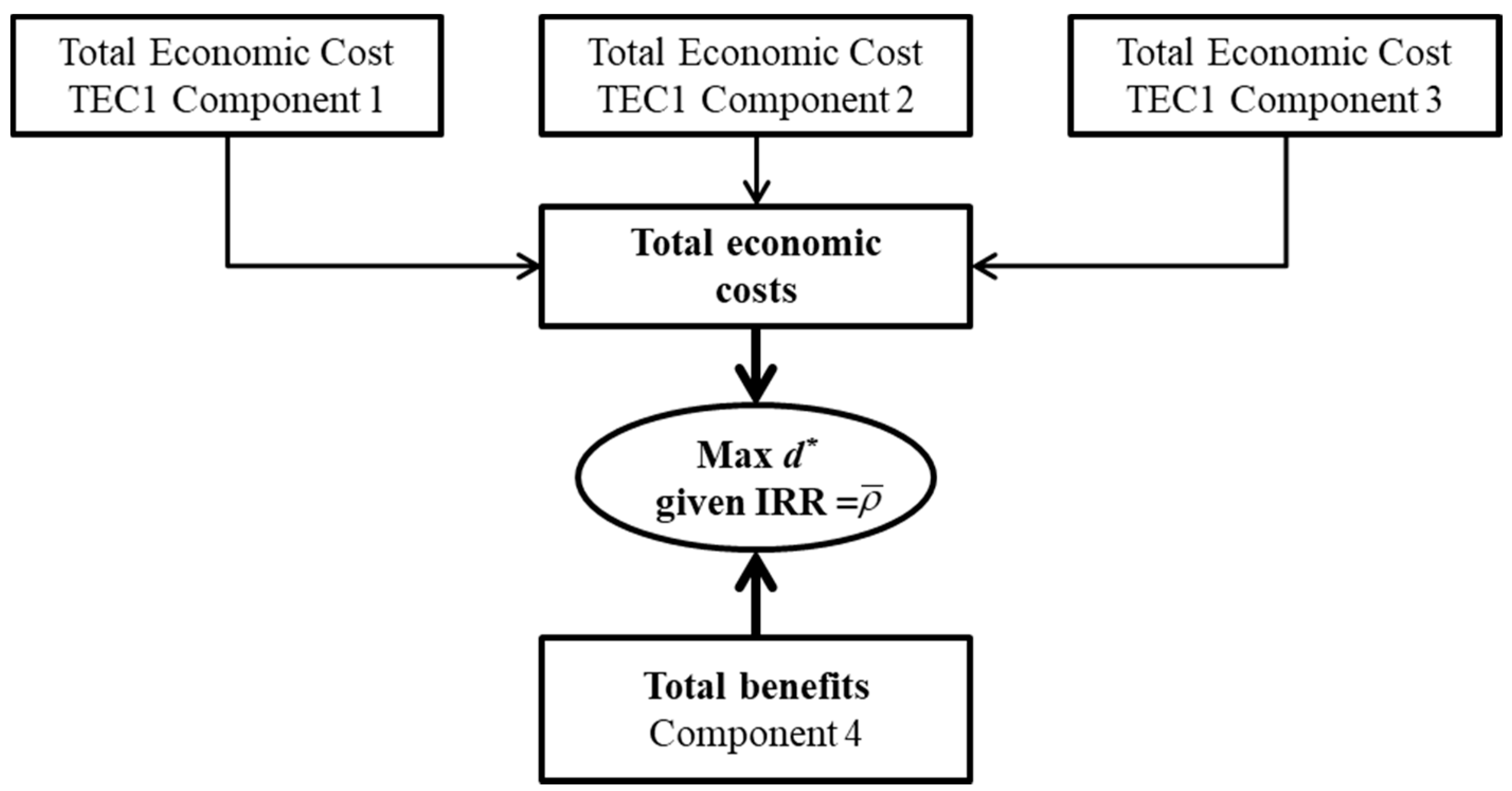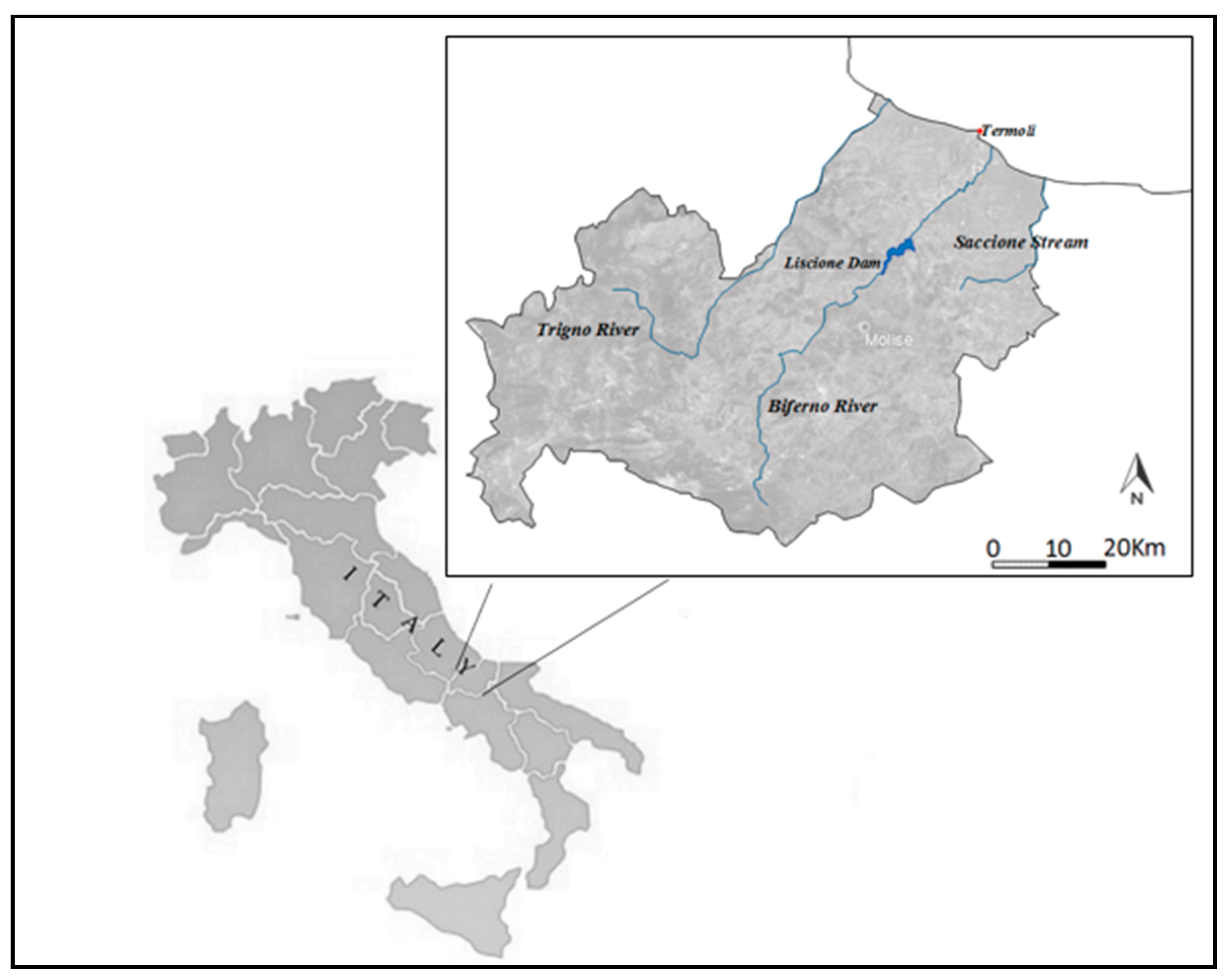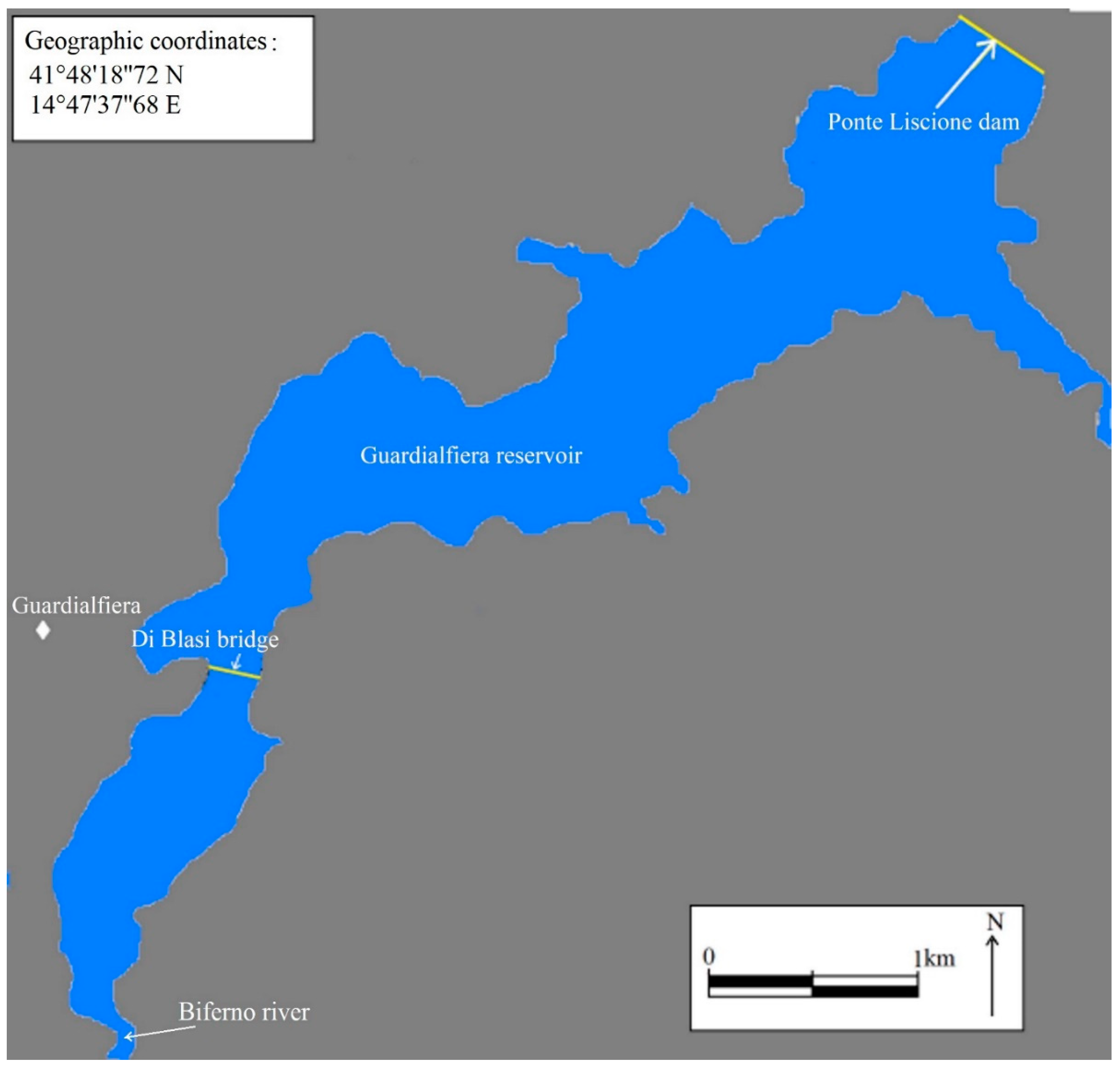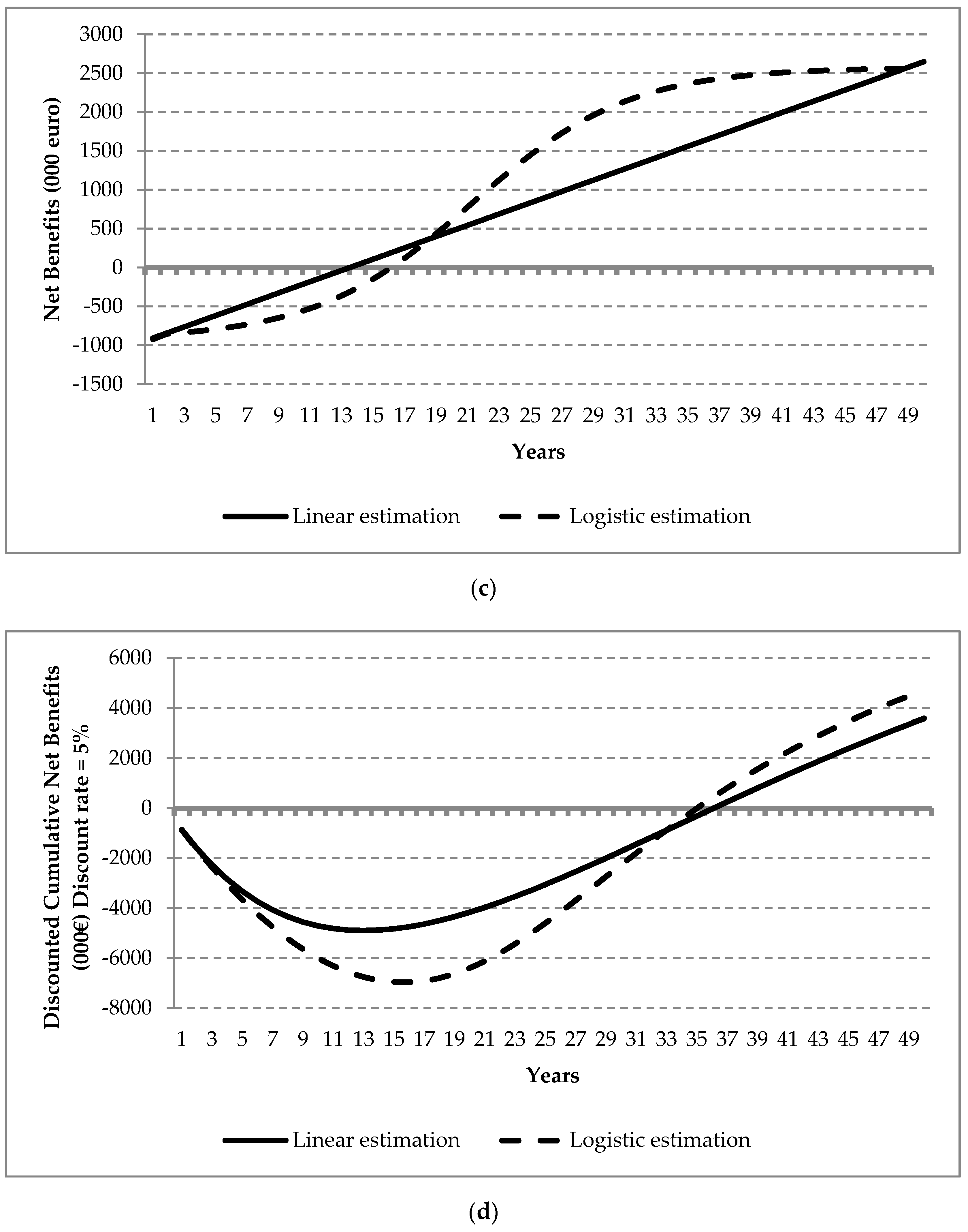The Reuse of Sediments Dredged from Artificial Reservoirs for Beach Nourishment: Technical and Economic Feasibility
Abstract
1. Introduction
- Identify the aspects to be considered from a theoretical, technical, and economic point of view;
- Define the measurement parameters, their measurement systems and their orders of magnitude;
- Build a theoretical background through which understand the role played by the joint product in the context of the feasibility appraisal;
- Define a methodology that allows us to determine the general conditions under which the investment aimed to improving coastal areas sustainability is feasible;
- Determine a variable on the basis of which the competent authority may or may not decide the management of the joint product.
2. Methods and Materials
2.1. The Conceptual Framework of the Cost-Benefit Approach
- Component 1—Dredging and nourishment costs
- Component 2—Transport costs
- Component 3—External costs
- Component 4—Benefits.
2.1.1. Component 1—Reservoir Dredging and Beach Nourishment Costs
2.1.2. Component 2—Transport Costs
2.1.3. Component 3—External Costs
2.1.4. Component 4—Benefits
- Travel cost;
- Contingent valuation;
- Hedonic price;
- Choice modelling.
- Costs for the use of beach equipment, estimated on the basis of direct investigations;
- Expenditure on catering and accommodation, estimated using multipliers calculated in similar studies;
- Other expenses usually associated with beach tourism consumption, also estimated on the basis of the existing literature.
- The value in euro per square meter of new beach available, including the volume of consumption expenditure induced by each tourist;
- The value of the multiplicative effects (λ), determined by the regional I/O matrix;
- The length of the tourist season;
- The degree of utilization of the tourist facilities during the season.
2.1.5. From Financial to Economic Values
2.2. Study Case
2.3. Main Parameters and Sources
3. Results and Discussions
- The benefits are differential (assumption with intervention minus assumption without intervention);
- The benefits are expressed by the change in coastal tourism value added;
- The benefits have been estimated over 50 years, with both a linear and a logistic function.
- BT = BS × (1 + λ)
- BS = BS1/BS2 × BS3 × BS4 × BS5 × BS6
- BS1 = daily price for a beach lot (EUR/day). The evaluation assumed an average beach area (lot) per tourist unit. In this simplified hypothesis, the tourist unit’s willingness to pay per lot corresponds to an average value that includes all the expenses incurred by the tourist unit and is independent from the number of tourists using the lot. A more accurate analysis would require an estimate of the number of tourists per lot and an evaluation of the expenditure per item;
- BS2 = lot of new beach available for rent to single tourist (m2);
- BS3 = number of days of the tourist season (days);
- BS4 = rate of coverage of the tourist facility (%days);
- BS5 = share of value added in turnover (%EUR);
- BS5 = total of new beach available annually (m2).
4. Conclusions
- The solution to the problem of sediment accumulation in reservoirs can be considered a mandatory choice of the policy maker, at least in the long term, given the difficulty, both economic and environmental, of creating new reservoirs;
- Investments that are targeted at solving the accumulation problem, are characterized by the possible existence of scope economies;
- The use of the sediments for the beach nourishment of coastlines subject to erosion is certainly a case in which scope economies are present;
- In the case of scope economies, the investment decision must be made following the assessment of all alternatives, which are directed to alternative productions, taking advantage of the same scope economies;
- The cost-benefit assessment is reduced to a comparison between the value of the positive externality and the difference between the transport costs of the joint investment and the extraction costs of the i-th investment;
- The results of the cost-benefit analysis carried out only on the initial comparison between ‘with’ and ‘without’ assumptions, show a possible sustainability of the proposed investment, even in the presence of highly unfavorable scenarios;
- The proposed investment is economically feasible for a relatively short distance dam-coastline. In the study case a maximum feasible distance (53.8 km with a linear demand model, 55 km with a logistic demand model, 35.7 km in presence of highly unfavorable scenarios) greater than the real distance (35 km) was obtained;
- The method applied to the case study is transferable to any scenario of beach nourishment project with sediments dredged from an artificial reservoir once the compatibility and the availability of suitable volumes of sediment has been verified.
Author Contributions
Funding
Acknowledgments
Conflicts of Interest
References
- De Vincenzo, A.; Covelli, C.; Molino, A.J.; Pannone, M.; Ciccaglione, M.; Molino, B. Long-Term Management Policies of Reservoirs: Possible Re-Use of Dredged Sediments for Coastal Nourishment. Water 2019, 11, 15. [Google Scholar] [CrossRef]
- Pannone, M.; De Vincenzo, A. Stochastic numerical analysis of anomalous longitudinal dispersion and dilution in shallow decelerating stream flows. Stoch. Environ. Res. Risk Assess. 2015, 29, 2087–2100. [Google Scholar] [CrossRef]
- De Vincenzo, A.; Brancati, F.; Pannone, M. An experimental analysis of bed load transport in gravel-bed braided rivers with high grain Reynolds numbers. Adv. Water Resour. 2016, 94, 160–173. [Google Scholar] [CrossRef]
- Mirauda, D.; De Vincenzo, A.; Pannone, M. Statistical characterization of flow field structure in evolving braided gravel beds. Spat. Stat. 2019, 34, 100268. [Google Scholar] [CrossRef]
- Ezz-Aldeen, M.; Hassan, R.; Ali, A.; Al-Ansari, N.; Knutsson, S. Watershed Sediment and Its Effect on Storage Capacity: Case Study of Dokan Dam Reservoir. Water 2018, 10, 858. [Google Scholar] [CrossRef]
- Ali, M.; Sterk, G.; Seeger, M.; Boersema, M.; Peters, P. Effect of hydraulic parameters on sediment transport capacity in overland flow over erodible beds. Hydrol. Earth Syst. Sci. 2012, 16, 591–601. [Google Scholar] [CrossRef]
- ICOLD. Sedimentation and Sustainable Use of Reservoirs and River Systems. 2009. Available online: https://www.icold-cigb.org/userfiles/files/CIRCULAR/CL1793Annex.pdf (accessed on 7 May 2020).
- De Vincenzo, A.; Molino, A.J.; Molino, B.; Scorpio, V. Reservoir rehabilitation: The new methodological approach of Economic Environmental Defence. Int. J. Sediment Res. 2017, 32, 288–294. [Google Scholar] [CrossRef]
- Brandt, S.A. Classification of geomorphological effects downstream of dams. Catena 2000, 40, 375–401. [Google Scholar] [CrossRef]
- Carling, P. The concept of dominant discharge applied to two gravel-bed streams in relation to channel stability thresholds. Earth Surf. Process. Landforms 1998, 13, 355–367. [Google Scholar] [CrossRef]
- Grant, G.E.; Schmidt, J.C.; Lewis, S.L. A Geological Framework for Interpreting Downstream Effects of Dams on Rivers. In A Peculiar River: Geology, Geomorphology, and Hydrology of the Deschutes River, Oregon; O’Connor, J.E., Grant, G.E., Eds.; American Geophysical Union (AGU): Washington, DC, USA, 2003. [Google Scholar]
- Graf, W.L. Downstream hydrologic and geomorphic effects of large dams on American rivers. Geomorphology 2006, 79, 336–360. [Google Scholar] [CrossRef]
- Morris, G.L.; Fan, J. Reservoir Sedimentation Handbook, Design and Management of Dams, Reservoirs and Watersheds for Sustainable Use; McGraw-Hill: New York, NY, USA, 1998. [Google Scholar]
- Williams, G.P.; Wolman, M.G. Downstream Effects of Dams on Alluvial Rivers; U.S. Geological Survey Professional Paper 1286; U.S. Geological Survey: Reston, VA, USA, 1984. [CrossRef]
- Andredaki, M.; Georgoulas, A.; Hrissanthou, V.; Kotsovinos, N. Assessment of reservoir sedimentation effect on coastal erosion in the case of Nestos River, Greece. Int. J. Sediment Res. 2014, 29, 34–48. [Google Scholar] [CrossRef]
- Kondolf, G.M. PROFILE: Hungry Water: Effects of Dams and Gravel Mining on River Channels. Environ. Manag. 1997, 21, 533–551. [Google Scholar] [CrossRef] [PubMed]
- Willis, C.M.; Griggs, G.B. Reductions in Fluvial Sediment Discharge by Coastal Dams in California and Implications for Beach Sustainability. J. Geol. 2003, 111, 167–182. [Google Scholar] [CrossRef]
- Hsu, T.-W.; Lin, T.-Y.; Tseng, I.-F. Human Impact on Coastal Erosion in Taiwan. J. Coast. Res. 2007, 234, 961–973. [Google Scholar] [CrossRef]
- Syvitski, J.P.M.; Vörösmarty, C.J.; Kettner, A.J.; Green, P.A. Impact of Humans on the Flux of Terrestrial Sediment to the Global Coastal Ocean. Science 2005, 308, 376–380. [Google Scholar] [CrossRef]
- Bergillos, R.J.; Rodríguez-Delgado, C.; Millares, A.; Ortega-Sánchez, M.; Losada, M.A. Impact of river regulation on a Mediterranean delta: Assessment of managed versus unmanaged scenarios. Water Resour. Res. 2016, 52, 5132–5148. [Google Scholar] [CrossRef]
- Molino, B.; Viparelli, R.; De Vincenzo, A. Effects of river network works and soil conservation measures on reservoir silting-up. Int. J. Sediment Res. 2007, 22, 273–281. [Google Scholar]
- De Vincenzo, A.; Molino, B.; Viparelli, R.; Caramuscio, P. A methodological approach for estimating turbidity in a river. Int. J. Sediment Res. 2011, 26, 112–119. [Google Scholar] [CrossRef]
- Carone, M.T.; Greco, M.; Molino, B. A sediment-filter ecosystem for reservoir rehabilitation. Ecol. Eng. 2006, 26, 182–189. [Google Scholar] [CrossRef]
- Covelli, C.; Cimorelli, L.; Pagliuca, D.N.; Molino, B.; Pianese, D. Assessment of Erosion in River Basins: A Distributed Model to Estimate the Sediment Production over Watersheds by a 3-Dimensional LS Factor in RUSLE Model. Hydrology 2020, 7, 13. [Google Scholar] [CrossRef]
- Scheuerlein, H. Downstream effects of dam construction and reservoir operation. In Proceedings of the 6th International Symposium on River Sedimentation, Management of Sediment: Philosophy, Aims, and Techniques, New Delhi, India, 7–11 November 1995; Balkema Rotterdam: Rotterdam, The Netherlands, 1995; pp. 1101–1108. [Google Scholar]
- Lai, J.S. Shen HW Flushing sediment through reservoirs. J. Hydraul. Res. 1996, 34, 237–255. [Google Scholar] [CrossRef]
- Chang, F.-J.; Lai, J.-S.; Kao, L.-S. Optimization of operation rule curves and flushing schedule in a reservoir. Hydrol. Process. 2003, 17, 1623–1640. [Google Scholar] [CrossRef]
- Hotchkiss, R.H.; Huang, X. Hydrosuction Sediment-Removal Systems (HSRS): Principles and Field Test. J. Hydraul. Eng. 1995, 121, 479–489. [Google Scholar] [CrossRef]
- Molino, B.; De Vincenzo, A.; Ferone, C.; Messina, F.; Colangelo, F.; Cioffi, R. Recycling of Clay Sediments for Geopolymer Binder Production. A New Perspective for Reservoir Management in the Framework of Italian Legislation: The Occhito Reservoir Case Study. Materials 2014, 7, 5603–5616. [Google Scholar] [CrossRef]
- Messina, F.; Ferone, C.; Molino, A.; Roviello, G.; Colangelo, F.; Molino, B.; Cioffi, R. Synergistic recycling of calcined clayey sediments and water potabilization sludge as geopolymer precursors: Upscaling from binders to precast paving cement-free bricks. Constr. Build. Mater. 2017, 133, 14–26. [Google Scholar] [CrossRef]
- Molino, B.; Bufalo, G.; De Vincenzo, A.; Ambrosone, L. Semiempirical Model for Assessing Dewatering Process by Flocculation of Dredged Sludge in an Artificial Reservoir. Appl. Sci. 2020, 10, 3051. [Google Scholar] [CrossRef]
- Alexandrakis, G.; Manasakis, C.; Kampanis, N.A. Valuating the effects of beach erosion to tourism revenue. A management perspective. Ocean Coast. Manag. 2015, 111, 1–11. [Google Scholar] [CrossRef]
- Post, J.C.; Lundin, C.G. Guidelines for Integrated Coastal Zone Management; World Bank: Washington, DC, USA, 1996. [Google Scholar] [CrossRef]
- Hernández-Delgado, E.A.; Rosado-Matías, B.J. Long-Lasting Impacts of Beach Renourishment on Near shore Urban Coral Reefs: A Glimpse of Future Impacts of Shoreline Erosion, Climate Change and Sea Level Rise. Ann. Mar. Biol. Res. 2017, 4, 1021. [Google Scholar]
- Peterson, C.H.; Bishop, M.J. Assessing the Environmental Impacts of Beach Nourishment. Bioscience 2005, 55, 887. [Google Scholar] [CrossRef]
- Ministero dell’Ambiente e Della Tutela del Territorio e del Mare; Legislative Decree No. 173; Gazzetta Ufficiale della Repubblica Italiana: Rome, Italy, 2016.
- Mishan, E.J. Cost-Benefit Analysis; Allen and Unwin: London, UK, 1971. [Google Scholar]
- Dasgupta, A.K.; Pearce, D.W. Cost-Benefit Analysis; Springer: Cham, Switzerland, 1972. [Google Scholar]
- Hufschmidt, M.M. Benefit-Cost Analysis: 1933–1985. J. Contemp Water Res. Educ. 2000, 116, 42–49. [Google Scholar]
- Palmieri, A.; Shah, F.; Annandale, G.; Dinar, A. Reservoir Conservation Volume I: The RESCON Approach; World Bank: Washington, DC, USA, 2003; Available online: http://documents.worldbank.org/curated/en/819541468138875126/pdf/349540v10Reservoir0conservation0RESCON.pdf (accessed on 7 May 2020).
- Kawashima, S. Conserving reservoir water storage: An economic appraisal. Water Resour. Res. 2007, 43, w05417. [Google Scholar] [CrossRef]
- WWAP (United Nations World Water Assessment Programme). The United Nations World Water Development Report 2014: Water and Energy; UNESCO: Paris, France, 2014. [Google Scholar]
- WWAP (World Water Assessment Programme). The United Nations World Water Development Report 4: Managing Water under Uncertainty and Risk; UNESCO: Paris, France, 2012. [Google Scholar]
- Dean, R.G. Realistic economic benefits from beach nourishment. Coast. Eng. Proc. 1988, 1, 116. [Google Scholar] [CrossRef]
- Houston, J.R. The Economic Value of Beaches—A 2013 update. Shore Beach 2013, 81, 3–11. [Google Scholar]
- Blackwell, B.D. The Value of a Recreational Beach Visit: An Application to Mooloolaba Beach and Comparisons with Other Outdoor Recreation Sites **This paper does not necessarily reflect the views of the NCME or AMC. Econ. Anal. Policy 2007, 37, 77–98. [Google Scholar] [CrossRef]
- Gopalakrishnan, S.; Smith, M.D.; Slott, J.M.; Murray, A.B. The value of disappearing beaches: A hedonic pricing model with endogenous beach width. J. Environ. Econ. Manag. 2011, 61, 297–310. [Google Scholar] [CrossRef]
- Finkl, C.W. What Might Happen to America’s Shorelines if Artificial Beach Replenishment is Curtailed: A Prognosis for Southeastern Florida and Other Sandy Regions Along Regressive Coasts. J. Coast Res. 1996, 12, III–IX. [Google Scholar]
- NOAA Coastal Services Center Institute for Water Resources, U.S. Army Corps of Engineers Economic and Social Effects of Changing Shorelines in the North Atlantic Region Final Report 2010, June 30. Available online: https://www.google.com.tw/url?sa=t&rct=j&q=&esrc=s&source=web&cd=&ved=2ahUKEwj976HTsK7rAhVXfSsKHb_BAA0QFjAAegQIBBAB&url=ftp%3A%2F%2Fftp.coast.noaa.gov%2Fpub%2Fsocioeconomic%2FNSMS%2FNorth%2520Atlantic%2FFinal%2520Coastal%2520Erosion%2520Report%2520June%252030.pdf&usg=AOvVaw25ioy2QzSiaaQZL7N8tYNE (accessed on 7 May 2020).
- Smith, M.D.; Slott, J.M.; McNamara, D.E.; Murray, A.B. Beach nourishment as a dynamic capital accumulation problem. J. Environ. Econ. Manag. 2009, 58, 58–71. [Google Scholar] [CrossRef]
- Lent, L.K. Economics of the Shoreline, An Annotated Bibliography for the National Shoreline Management Study; IWR Report 04-NSMS-5; USACE: Washington, DC, USA, 2004.
- Lupino, P.; Riccardi, C.; Scaloni, P.; Cost-Benefit Analysis for Beach Nourishment Work. Osservatorio Regionale dei Litorali Laziali Report 2005. Available online: https://pdfs.semanticscholar.org/6cfe/ec17dd18de03521dce0d54af85dc999ef408.pdf (accessed on 7 May 2020).
- Chrysalis Consulting Inc. The Economic Effects of a Five Year Nourishment Program for the Ocean Beaches of Delaware, Updated, research conducted for Delaware’s Department of Natural Resources and Environmental Control. 2007. Available online: http://www.dnrec.delaware.gov/swc/Shoreline/Documents/2007%20The%20Economic%20Effects%20of%20a%20Five%20Year%20Nourishment%20Program.pdf (accessed on 7 May 2020).
- NRC (National Research Council). Reducing Coastal Risk on the East and Gulf Coasts; The National Academies Press: Washington, DC, USA, 2014. [Google Scholar] [CrossRef][Green Version]
- Zoppi, C.; Zanuttigh, B. Analisi preliminare dell’utilizzo delle sabbie dragate dal fiume Po per il ripascimento di spiagge del litorale emiliano-romagnolo. In Proceedings of the XXXIII Convegno Nazionale di Idraulica e Costruzioni Idrauliche, University of Brescia, Brescia, Italy, 10–15 September 2012. (In Italian). [Google Scholar]
- Panzar, J.C. Willig RD Economies of Scope. Am. Econ. Rev. 1981, 71, 268–272. [Google Scholar]
- Goldhar, J.D.; Jelinek, M. Plan for Economies of Scope. Harv. Bus. Rev. 1983, 61, 141–148. [Google Scholar]
- King, P.G. The Economics of Regional Sediment Management in Ventura and Santa Barbara Counties: A Pilot Study. Interim Report to the Coastal Sediment Management Workgroup, San Francisco, 2006. Available online: https://calisphere.org/item/ark:/86086/n2s181fq/ (accessed on 17 August 2020).
- Momsen, J.H.; Sinclair, M.T.; Stabler, M. The Economics of Tourism. Econ. Geogr. 1999, 75, 211. [Google Scholar] [CrossRef]
- Antonelli, U.; Paltrinieri, D.; Viglione, M. Marine Sand Deposit, Nourishment Projects and Economic Value of Beaches in Italy—A New Policy Approach for Coastal Protection and Suitable Tourism. In Proceedings of the National Conference on Beach Preservation Technology, Sarasota, FL, USA, 1–3 February 2006. [Google Scholar]
- Committee on Beach Nourishment and Protection, Marine Board, Commission on Engineering and Technical Systems; National Research Council. Beach Nourishment and Protection; The National Academies Press: Washington, DC, USA, 1995. [Google Scholar]
- European Commission. Guide to Cost-Benefit Analysis in Investment Projects; Directorate-General for Regional and Urban Policy: Brussels, Belgium, 2015. [Google Scholar]
- McConnell, K.E. Congestion and Willingness to Pay: A Study of Beach Use. Land Econ. 1977, 53, 185. [Google Scholar] [CrossRef]
- Massiani, J. How to Value the Benefits of a Recreational Area? A Cost-Benefit Analysis of the Conversion of a Brownfield to a Public Beach in Muggia (Italy). Rev. Econ. Anal. 2013, 5, 86–102. [Google Scholar]
- Rosskopf, C.M.; Di Paola, G.; Atkinson, D.E.; Rodríguez, G.; Walker, I.J. Recent shoreline evolution and beach erosion along the central Adriatic coast of Italy: The case of Molise region. J. Coast. Conserv. 2017, 22, 879–895. [Google Scholar] [CrossRef]
- Herman, J.D.; Reed, P.; Zeff, H.B.; Characklis, G.W. How Should Robustness Be Defined for Water Systems Planning under Change? J. Water Resour. Plan. Manag. 2015, 141, 04015012. [Google Scholar] [CrossRef]
- Kwakkel, J.; Pruyt, E. Exploratory Modeling and Analysis, an approach for model-based foresight under deep uncertainty. Technol. Forecast. Soc. Chang. 2013, 80, 419–431. [Google Scholar] [CrossRef]






| Acronyms | Key Variable | Unit |
|---|---|---|
| CBA | Cost Benefit Analysis | |
| RESCON | REServoir CONservation | |
| NPV | Net Present Value | € |
| IRR | Internal Rate of Return | % |
| TEC | Total Economic Cost | € |
| CF | Conversion Factors | |
| DR | DRedging cost | € |
| BN | Beach Nourishment cost | € |
| AS | Available Sediment | ton |
| NNB | New Nourished Beach | m2 |
| VOC | Vehicles Operating Cost | € |
| SQ | Quantity of Sediment to be moved | m3 |
| EC | Environmental Costs | € |
| Parameter | Description | Values | Source |
|---|---|---|---|
| δ (km) | actual distance from the coast and Liscione Dam | 35 | field study |
| dmax (km) | maximum achievable distance under the constraints | 53.7–55.4 | model |
| θ | amount of compatible sediment from sediment unit | 0.7 | field study |
| μ | m3 to m2 of new nourished beach | 15 | field study |
| α (ton/m3) | density | 2.0 | Field study |
| €/Km | unit cost per kilometer (€) | 2.58 | ** |
| ton/V | transport capacity in tons per vehicle | 40 | standard |
| €/m2 | value in euro per square meter of new beach available per day | 1.39 | field study |
| share of value added in turnover | 0.5 | I/O matrix * | |
| λ | value of the multiplicative effects | 3.0 | I/O matrix * |
| days | length of the tourist season | 90 | field study |
| degree of facilities utilization during the season | 0.7 | field study |
| Parameters | Demand | ||
|---|---|---|---|
| Linear | Logistic | ||
| π | Discount rate | 5% | 5% |
| IRR | 7.0% | 7.0% | |
| NPV | 3,602,124 | 4,705,241 | |
| Max distance (km) | 53.7 | 55.40 | |
| δ | Real distance (km) | 35 | 35 |
| >δ | Condition | YES | YES |
© 2020 by the authors. Licensee MDPI, Basel, Switzerland. This article is an open access article distributed under the terms and conditions of the Creative Commons Attribution (CC BY) license (http://creativecommons.org/licenses/by/4.0/).
Share and Cite
Bagarani, M.; De Vincenzo, A.; Ievoli, C.; Molino, B. The Reuse of Sediments Dredged from Artificial Reservoirs for Beach Nourishment: Technical and Economic Feasibility. Sustainability 2020, 12, 6820. https://doi.org/10.3390/su12176820
Bagarani M, De Vincenzo A, Ievoli C, Molino B. The Reuse of Sediments Dredged from Artificial Reservoirs for Beach Nourishment: Technical and Economic Feasibility. Sustainability. 2020; 12(17):6820. https://doi.org/10.3390/su12176820
Chicago/Turabian StyleBagarani, Massimo, Annamaria De Vincenzo, Corrado Ievoli, and Bruno Molino. 2020. "The Reuse of Sediments Dredged from Artificial Reservoirs for Beach Nourishment: Technical and Economic Feasibility" Sustainability 12, no. 17: 6820. https://doi.org/10.3390/su12176820
APA StyleBagarani, M., De Vincenzo, A., Ievoli, C., & Molino, B. (2020). The Reuse of Sediments Dredged from Artificial Reservoirs for Beach Nourishment: Technical and Economic Feasibility. Sustainability, 12(17), 6820. https://doi.org/10.3390/su12176820






